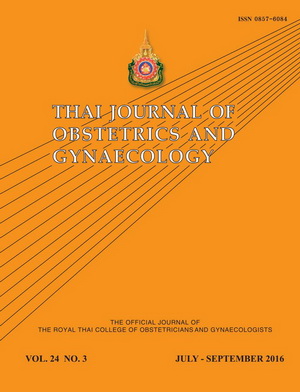Abnormal Hysterosalpingographic Findings in Infertile Women
Main Article Content
Abstract
Objective: to determine the rate and patterns of hysterosalpingography (HSG) abnormality among infertile women at Srinagarind Hospital, Khon Kean University, Thailand.
Materials and methods: The study patients were identified through the reports of the Infertile Clinic. In our hospital, HSG was routinely performed in all women undergoing an evaluation of infertility problems. Medical records were abstracted for baseline characteristics, types of infertility, and details of HSG findings. A 95% confidence interval (CI) was calculated to demonstrate the precision of data. Logistic regression model was used to determine an independent impact of the type of infertility on abnormal HSG findings.
Results: Overall, 589 women were reviewed. The mean ± SD age was 32.9 ± 5.0 years. Secondary infertility was noted in 163 (27.7%) women. Abnormal HSG was noted in 227 (38.5%, 95% CI, 34.6%-42.6%) women. The most common abnormal HSG findings were tubal occlusion and hydrosalpinx. When adjusted with patients’ age, women with secondary infertility carried a higher risk of having abnormal HSG finding compared to those with primary infertility (an adjusted odds ratio, 2.44; 95% CI, 1.68-3.54).
Conclusion: Rate of abnormal HSG findings among infertile women in our setting was approximately 40%. Type of infertility was independently associated with abnormal HSG findings.

